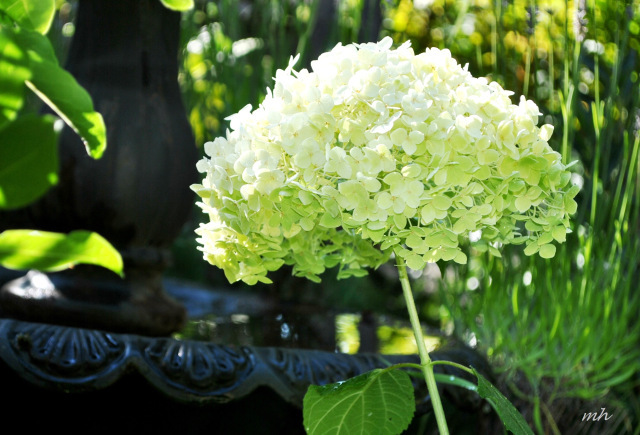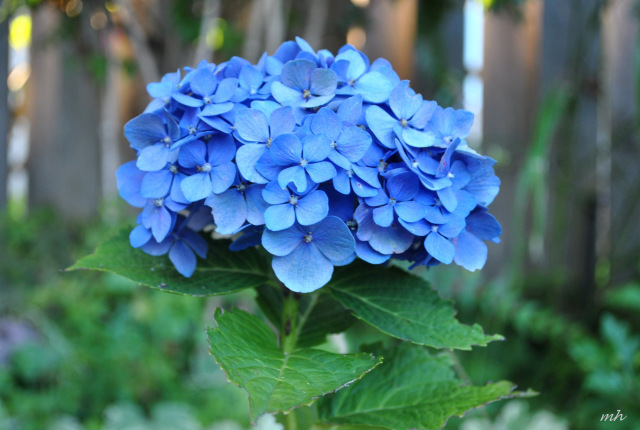Following just a few simple growing tips for hydrangea will produce healthy plants with fluffy colorful blooms year after year.
Planting Your Hydrangea
Planting your Hydrangea in early spring or in the fall is ideal. When you are planting a Hydrangea, remember that the blooms and stems must be protected from strong winds and the hot afternoon sun. Avoid planting in open areas where strong winds could break stems. Planting on the eastern side of a building ensures that, in the afternoon, when the sun is at its hottest, your plants are in the shade.
Make sure your plant has good drainage. If the soil is too wet, the roots might rot, and the plant will die. Incorporate a lot of organic matter and an all-purpose slow-release fertilizer into the soil to give your hydrangea a strong start.
General Hydrangea Care
If you plant them in the summer, they need a lot more water in the beginning to establish the root system.
Most varieties thrive in full sun to part shade, as long as they are planted in moist, rich soil.
Water deeply once a week, and maybe more, if the weather is particularly hot or dry.
Hydrangea fertilization needs vary greatly, depending on your intended bloom color. Certain elements of the fertilizer affect the soil pH, which is a major determinant of bloom color in the pink/blue Hydrangea varieties.
Pruning Hydrangea
Hydrangeas can live for many years without ever needing to be pruned, but if your shrubs grow out of bounds or lose flowering vigor, then there are some essential pruning guidelines you must follow to ensure bountiful blooms the next year!
Hydrangea macrophylla and H. quercifolia: These generally bloom on old wood and require little pruning. Prune spent blooms immediately after flowering (midsummer), or remove only dead, damaged or unsightly wood.
Hydrangea macrophylla (Bigleaf, Mophead, or Lacecap Hydrangeas)
These Hydrangeas begin blooming in early to midsummer and can continue until summer's end, so they set their bloom buds during late summer or early fall. When pruning mopheads, you have two options, and will probably end up doing a combination of both:
1. Cut back the flowering shoots to the next bud, thus giving the branches a trim that removes the spent blooms without damaging the buds that will bloom next year. Do this right after flowering, but before midsummer.
2. On older shrubs that have lost flowering vigor, cut up to a third of entire stems at the base in late winter to improve flowering vigor. Ideally, you should cut the oldest stems, leaving younger mature stems that are loaded with buds for next year, but sometimes you have a lopsided or crowded Hydrangea that must be pruned to maintain a pleasing shape. The main purpose of cutting off entire stems is to do away with elderly or poorly flowering parts of the shrub, thus letting in more air and light AND encouraging the growth of healthy new branches.In mild climates that may experience warm spells in winter, be careful of the urge to get out in the garden and start pruning before late winter. If you prune too early, you could encourage dormant buds to break, leaving tender growth susceptible to frost and freeze damage.
Exception:
If you have a reblooming variety such as Penny Mac that flowers on new wood as well as old wood, you'll want to prune a little every year just to keep the new wood coming.

Hydrangea quercifolia (Oakleaf Hydrangea)
You can get away without pruning Oakleaf Hydrageas at all, but if you want to keep them well-shaped, cut dead stems back at the base in late winter or early spring.
Hydrangea arborescens and H. paniculata: These shrubs bloom on new wood and actually produce larger blooms if cut back to the ground in late winter.
Hydrangea arborescens (Smooth Hydrangea)
This is one of the easiest Hydrangeas to prune. Because it blooms only on new wood, you can just cut it back to the ground in late winter, before any new buds appear. If you experience some flopping of flowering branches, then leave a framework of old growth to help support the branches by only cutting stems back to 2 feet from the ground.
Hydrangea paniculata (Pee Gee or Panicle Hydrangeas)
Prune this Hydrangea in late winter to keep the plants from becoming overgrown and encourage more new growth, more flower buds, and larger blooms. You can remove dead flowers, as soon as they become unattractive and clean up the overall shape of the plant.
Hydrangea petiolaris:
Hydrangea petiolaris (Climbing Hydrangea)
Climbing Hydrangea requires little to no pruning, but if you need to trim it to keep it in bounds, you should prune it just after flowering. Cut back last year's flower shoots to 1 to 2 inches and pruning out shoots that fail to cling or have pulled away from their support. Remember, Hydrangeas are shade tolerant, but they do require adequate sunlight and irrigation to bloom properly. In northern climates and coastal areas, Hydrangeas will grow beautifully in full sun, but in warmer southern areas, a location in part shade where the shrub receives full to partial morning sun with protection from harsh afternoon sun is ideal.Placed in the right location, given ample moisture, and pruned using the guidelines above, your Hydrangeas will be an abundant source of gorgeous blooms long into the future.
How to Adjust Hydrangea Color

Hydrangeas may produce pink, blue, or lavender blooms, depending on where it’s planted and how it’s fed. The presence of aluminum in the plant ultimately determines the color, and pH affects the uptake of aluminum. Alkaline soils, pH of 6.0 or more, are more likely to produce pink blooms, and more acidic soils, pH 4.5 to 5.5, produce blue flowers.
Pink hydrangeas can be turned blue by applying aluminum sulfate to lower the pH and add aluminum to the soil. Applying lime to raise the pH level will help blue hydrangeas turn pink. If your soil naturally produces very blue or very pink hydrangea flowers, you may need to grow your hydrangeas in containers or raised beds to achieve the desired color. If you do attempt to change the color of your blooms by adding these minerals, dilute them well, and add sparingly. It is very easy to scorch your plants by adding too much. White hydrangeas are not affected by efforts to change bloom color.
Using Hydrangeas for Cut-Flower Arrangements
Cut them just as blooms fully develop.
Cut your flowers in the early morning, before the sun comes up to evaporate some of their moisture.
Cutting at diagonal will allow the stem to take in the most amount of water, some people will even cut slits or fray the ends of the stems a little.
Place your freshly cut flowers in a bucket of cool water to soak for an hour or two before arranging your final product.
Use a commercial floral preservative to get the best results. This will feed your flowers, maintain a constant pH, and will serve as an anti-microbial to prevent premature decay. You should be able to find this at a local nursery.
Keep in mind that many gardeners and florists complain that hydrangeas wilt faster than other cut flowers and may require a little extra planning.
Keep it out of drafty areas and direct sunlight to prevent the flowers from drying. Finally, you can just sit back and admire your new décor or enjoy your special moment.
By waysidegardens.com